Input interpretation

NH_3 ammonia + MnO_2 manganese dioxide ⟶ H_2O water + N_2 nitrogen + Mn_2O_3 manganese(III) oxide
Balanced equation
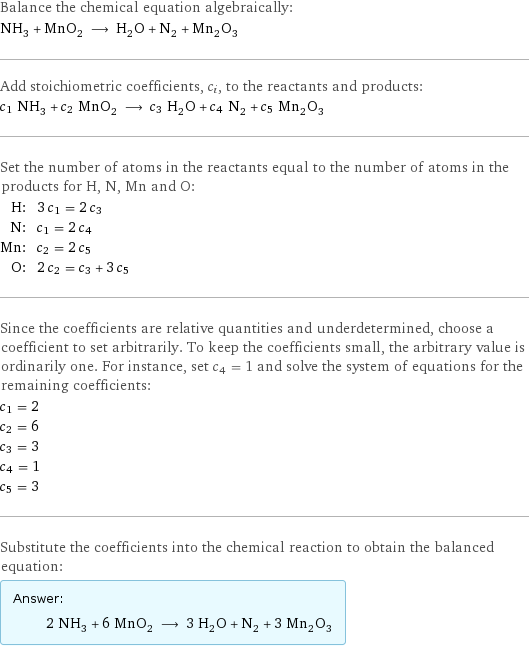
Balance the chemical equation algebraically: NH_3 + MnO_2 ⟶ H_2O + N_2 + Mn_2O_3 Add stoichiometric coefficients, c_i, to the reactants and products: c_1 NH_3 + c_2 MnO_2 ⟶ c_3 H_2O + c_4 N_2 + c_5 Mn_2O_3 Set the number of atoms in the reactants equal to the number of atoms in the products for H, N, Mn and O: H: | 3 c_1 = 2 c_3 N: | c_1 = 2 c_4 Mn: | c_2 = 2 c_5 O: | 2 c_2 = c_3 + 3 c_5 Since the coefficients are relative quantities and underdetermined, choose a coefficient to set arbitrarily. To keep the coefficients small, the arbitrary value is ordinarily one. For instance, set c_4 = 1 and solve the system of equations for the remaining coefficients: c_1 = 2 c_2 = 6 c_3 = 3 c_4 = 1 c_5 = 3 Substitute the coefficients into the chemical reaction to obtain the balanced equation: Answer: | | 2 NH_3 + 6 MnO_2 ⟶ 3 H_2O + N_2 + 3 Mn_2O_3
Structures

+ ⟶ + +
Names

ammonia + manganese dioxide ⟶ water + nitrogen + manganese(III) oxide
Reaction thermodynamics
Enthalpy
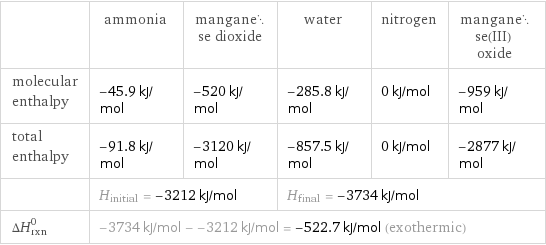
| ammonia | manganese dioxide | water | nitrogen | manganese(III) oxide molecular enthalpy | -45.9 kJ/mol | -520 kJ/mol | -285.8 kJ/mol | 0 kJ/mol | -959 kJ/mol total enthalpy | -91.8 kJ/mol | -3120 kJ/mol | -857.5 kJ/mol | 0 kJ/mol | -2877 kJ/mol | H_initial = -3212 kJ/mol | | H_final = -3734 kJ/mol | | ΔH_rxn^0 | -3734 kJ/mol - -3212 kJ/mol = -522.7 kJ/mol (exothermic) | | | |
Gibbs free energy
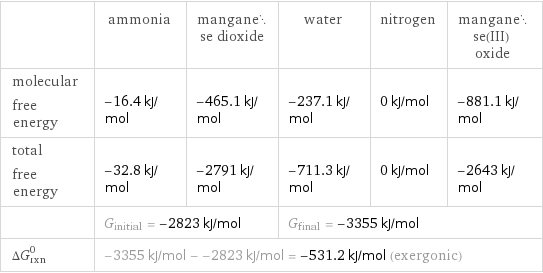
| ammonia | manganese dioxide | water | nitrogen | manganese(III) oxide molecular free energy | -16.4 kJ/mol | -465.1 kJ/mol | -237.1 kJ/mol | 0 kJ/mol | -881.1 kJ/mol total free energy | -32.8 kJ/mol | -2791 kJ/mol | -711.3 kJ/mol | 0 kJ/mol | -2643 kJ/mol | G_initial = -2823 kJ/mol | | G_final = -3355 kJ/mol | | ΔG_rxn^0 | -3355 kJ/mol - -2823 kJ/mol = -531.2 kJ/mol (exergonic) | | | |
Entropy
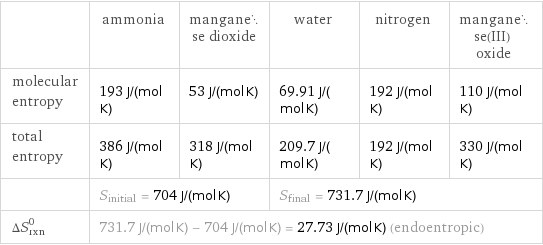
| ammonia | manganese dioxide | water | nitrogen | manganese(III) oxide molecular entropy | 193 J/(mol K) | 53 J/(mol K) | 69.91 J/(mol K) | 192 J/(mol K) | 110 J/(mol K) total entropy | 386 J/(mol K) | 318 J/(mol K) | 209.7 J/(mol K) | 192 J/(mol K) | 330 J/(mol K) | S_initial = 704 J/(mol K) | | S_final = 731.7 J/(mol K) | | ΔS_rxn^0 | 731.7 J/(mol K) - 704 J/(mol K) = 27.73 J/(mol K) (endoentropic) | | | |
Equilibrium constant
![Construct the equilibrium constant, K, expression for: NH_3 + MnO_2 ⟶ H_2O + N_2 + Mn_2O_3 Plan: • Balance the chemical equation. • Determine the stoichiometric numbers. • Assemble the activity expression for each chemical species. • Use the activity expressions to build the equilibrium constant expression. Write the balanced chemical equation: 2 NH_3 + 6 MnO_2 ⟶ 3 H_2O + N_2 + 3 Mn_2O_3 Assign stoichiometric numbers, ν_i, using the stoichiometric coefficients, c_i, from the balanced chemical equation in the following manner: ν_i = -c_i for reactants and ν_i = c_i for products: chemical species | c_i | ν_i NH_3 | 2 | -2 MnO_2 | 6 | -6 H_2O | 3 | 3 N_2 | 1 | 1 Mn_2O_3 | 3 | 3 Assemble the activity expressions accounting for the state of matter and ν_i: chemical species | c_i | ν_i | activity expression NH_3 | 2 | -2 | ([NH3])^(-2) MnO_2 | 6 | -6 | ([MnO2])^(-6) H_2O | 3 | 3 | ([H2O])^3 N_2 | 1 | 1 | [N2] Mn_2O_3 | 3 | 3 | ([Mn2O3])^3 The equilibrium constant symbol in the concentration basis is: K_c Mulitply the activity expressions to arrive at the K_c expression: Answer: | | K_c = ([NH3])^(-2) ([MnO2])^(-6) ([H2O])^3 [N2] ([Mn2O3])^3 = (([H2O])^3 [N2] ([Mn2O3])^3)/(([NH3])^2 ([MnO2])^6)](../image_source/905ccd0d2ccdf1090a5a86805e06ffec.png)
Construct the equilibrium constant, K, expression for: NH_3 + MnO_2 ⟶ H_2O + N_2 + Mn_2O_3 Plan: • Balance the chemical equation. • Determine the stoichiometric numbers. • Assemble the activity expression for each chemical species. • Use the activity expressions to build the equilibrium constant expression. Write the balanced chemical equation: 2 NH_3 + 6 MnO_2 ⟶ 3 H_2O + N_2 + 3 Mn_2O_3 Assign stoichiometric numbers, ν_i, using the stoichiometric coefficients, c_i, from the balanced chemical equation in the following manner: ν_i = -c_i for reactants and ν_i = c_i for products: chemical species | c_i | ν_i NH_3 | 2 | -2 MnO_2 | 6 | -6 H_2O | 3 | 3 N_2 | 1 | 1 Mn_2O_3 | 3 | 3 Assemble the activity expressions accounting for the state of matter and ν_i: chemical species | c_i | ν_i | activity expression NH_3 | 2 | -2 | ([NH3])^(-2) MnO_2 | 6 | -6 | ([MnO2])^(-6) H_2O | 3 | 3 | ([H2O])^3 N_2 | 1 | 1 | [N2] Mn_2O_3 | 3 | 3 | ([Mn2O3])^3 The equilibrium constant symbol in the concentration basis is: K_c Mulitply the activity expressions to arrive at the K_c expression: Answer: | | K_c = ([NH3])^(-2) ([MnO2])^(-6) ([H2O])^3 [N2] ([Mn2O3])^3 = (([H2O])^3 [N2] ([Mn2O3])^3)/(([NH3])^2 ([MnO2])^6)
Rate of reaction
![Construct the rate of reaction expression for: NH_3 + MnO_2 ⟶ H_2O + N_2 + Mn_2O_3 Plan: • Balance the chemical equation. • Determine the stoichiometric numbers. • Assemble the rate term for each chemical species. • Write the rate of reaction expression. Write the balanced chemical equation: 2 NH_3 + 6 MnO_2 ⟶ 3 H_2O + N_2 + 3 Mn_2O_3 Assign stoichiometric numbers, ν_i, using the stoichiometric coefficients, c_i, from the balanced chemical equation in the following manner: ν_i = -c_i for reactants and ν_i = c_i for products: chemical species | c_i | ν_i NH_3 | 2 | -2 MnO_2 | 6 | -6 H_2O | 3 | 3 N_2 | 1 | 1 Mn_2O_3 | 3 | 3 The rate term for each chemical species, B_i, is 1/ν_i(Δ[B_i])/(Δt) where [B_i] is the amount concentration and t is time: chemical species | c_i | ν_i | rate term NH_3 | 2 | -2 | -1/2 (Δ[NH3])/(Δt) MnO_2 | 6 | -6 | -1/6 (Δ[MnO2])/(Δt) H_2O | 3 | 3 | 1/3 (Δ[H2O])/(Δt) N_2 | 1 | 1 | (Δ[N2])/(Δt) Mn_2O_3 | 3 | 3 | 1/3 (Δ[Mn2O3])/(Δt) (for infinitesimal rate of change, replace Δ with d) Set the rate terms equal to each other to arrive at the rate expression: Answer: | | rate = -1/2 (Δ[NH3])/(Δt) = -1/6 (Δ[MnO2])/(Δt) = 1/3 (Δ[H2O])/(Δt) = (Δ[N2])/(Δt) = 1/3 (Δ[Mn2O3])/(Δt) (assuming constant volume and no accumulation of intermediates or side products)](../image_source/f64abd4dc794d634d3d8764695ecdac9.png)
Construct the rate of reaction expression for: NH_3 + MnO_2 ⟶ H_2O + N_2 + Mn_2O_3 Plan: • Balance the chemical equation. • Determine the stoichiometric numbers. • Assemble the rate term for each chemical species. • Write the rate of reaction expression. Write the balanced chemical equation: 2 NH_3 + 6 MnO_2 ⟶ 3 H_2O + N_2 + 3 Mn_2O_3 Assign stoichiometric numbers, ν_i, using the stoichiometric coefficients, c_i, from the balanced chemical equation in the following manner: ν_i = -c_i for reactants and ν_i = c_i for products: chemical species | c_i | ν_i NH_3 | 2 | -2 MnO_2 | 6 | -6 H_2O | 3 | 3 N_2 | 1 | 1 Mn_2O_3 | 3 | 3 The rate term for each chemical species, B_i, is 1/ν_i(Δ[B_i])/(Δt) where [B_i] is the amount concentration and t is time: chemical species | c_i | ν_i | rate term NH_3 | 2 | -2 | -1/2 (Δ[NH3])/(Δt) MnO_2 | 6 | -6 | -1/6 (Δ[MnO2])/(Δt) H_2O | 3 | 3 | 1/3 (Δ[H2O])/(Δt) N_2 | 1 | 1 | (Δ[N2])/(Δt) Mn_2O_3 | 3 | 3 | 1/3 (Δ[Mn2O3])/(Δt) (for infinitesimal rate of change, replace Δ with d) Set the rate terms equal to each other to arrive at the rate expression: Answer: | | rate = -1/2 (Δ[NH3])/(Δt) = -1/6 (Δ[MnO2])/(Δt) = 1/3 (Δ[H2O])/(Δt) = (Δ[N2])/(Δt) = 1/3 (Δ[Mn2O3])/(Δt) (assuming constant volume and no accumulation of intermediates or side products)
Chemical names and formulas
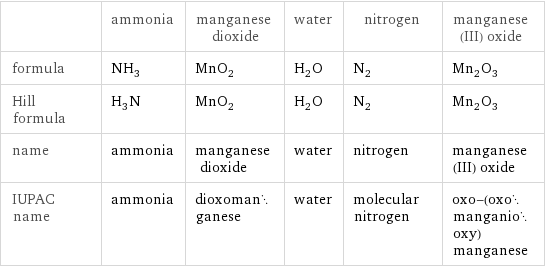
| ammonia | manganese dioxide | water | nitrogen | manganese(III) oxide formula | NH_3 | MnO_2 | H_2O | N_2 | Mn_2O_3 Hill formula | H_3N | MnO_2 | H_2O | N_2 | Mn_2O_3 name | ammonia | manganese dioxide | water | nitrogen | manganese(III) oxide IUPAC name | ammonia | dioxomanganese | water | molecular nitrogen | oxo-(oxomanganiooxy)manganese
Substance properties
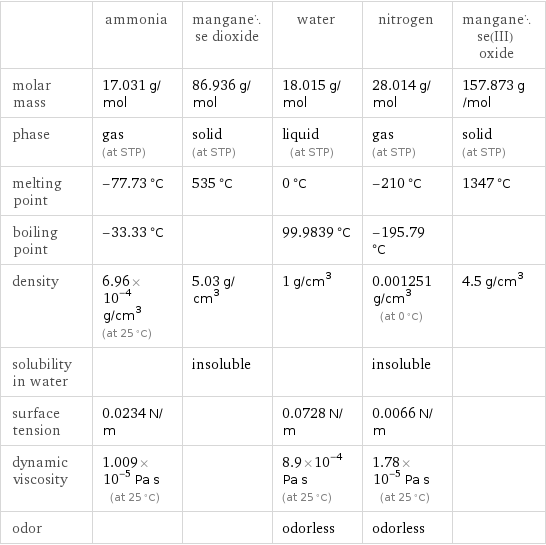
| ammonia | manganese dioxide | water | nitrogen | manganese(III) oxide molar mass | 17.031 g/mol | 86.936 g/mol | 18.015 g/mol | 28.014 g/mol | 157.873 g/mol phase | gas (at STP) | solid (at STP) | liquid (at STP) | gas (at STP) | solid (at STP) melting point | -77.73 °C | 535 °C | 0 °C | -210 °C | 1347 °C boiling point | -33.33 °C | | 99.9839 °C | -195.79 °C | density | 6.96×10^-4 g/cm^3 (at 25 °C) | 5.03 g/cm^3 | 1 g/cm^3 | 0.001251 g/cm^3 (at 0 °C) | 4.5 g/cm^3 solubility in water | | insoluble | | insoluble | surface tension | 0.0234 N/m | | 0.0728 N/m | 0.0066 N/m | dynamic viscosity | 1.009×10^-5 Pa s (at 25 °C) | | 8.9×10^-4 Pa s (at 25 °C) | 1.78×10^-5 Pa s (at 25 °C) | odor | | | odorless | odorless |
Units
